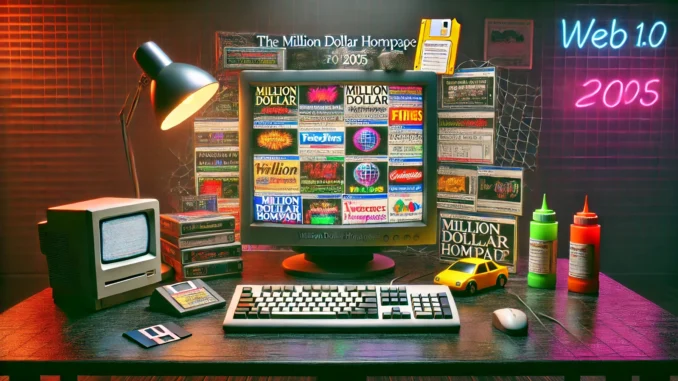
The Internet’s Strangest Gold Rush
Imagine making a million dollars by selling tiny squares on a website. No product, no service—just pixels.
In 2005, a university student, Alex Tew, did exactly that. The Million Dollar Homepage wasn’t just an internet stunt—it was a blueprint for digital hype that still shapes online culture today.
At the time, the internet was still evolving, and online advertising was nowhere near as sophisticated as it is today. Forums like Slashdot and Something Awful debated whether Tew was a genius or just lucky. Some saw it as a “get-rich-quick” scheme; others, as an innovative marketing experiment. The site became a social experiment in online hype, proving that curiosity, novelty, and a touch of scarcity could turn anything into a sensation.
A Web 1.0 Time Capsule
The internet of 2005 was very different. Social media was just starting to emerge, and Google had not yet taken full control of online advertising. The Million Dollar Homepage thrived on scarcity and curiosity, leveraging the viral nature of the early web. Each pixel was nearly useless on its own, but together, they created a chaotic mosaic of internet culture—filled with brands, personal sites, and forgotten businesses.
Some advertisers were startups hoping for exposure; others were pranksters who bought pixels just for fun. Among the digital real estate, you could find online casinos, tech blogs, and even marriage proposals. The site’s random patchwork of banner ads made it an oddly captivating spectacle, drawing millions of curious visitors. Today, it remains a frozen moment in time, a digital artefact of the early 2000s web.
How It Shaped the Internet Today
Although The Million Dollar Homepage is now more of an internet relic, its core ideas still influence the modern web.
1. Digital Scarcity & NFTs
The Million Dollar Homepage proved that people would pay for digital space just because it was scarce—long before anyone had heard of NFTs.
In many ways, it was an NFT before NFTs existed—except you didn’t need a blockchain, just a few dollars and a sense of humour.
2. The Birth of Online Virality
Tew’s project was an early example of engineered virality. It spread through word-of-mouth, blogs, and media coverage, not paid ads. This grassroots momentum is something today’s digital marketers still aim for—whether through viral TikTok challenges, meme marketing, or crowdfunding campaigns.
3. Attention as Currency
The Million Dollar Homepage wasn’t just about selling ad space; it was about capturing attention. Its chaotic design made people want to explore it, much like how today’s social media platforms are designed to keep users scrolling. This battle for attention defines the modern internet, from clickbait headlines to algorithm-driven content.
4. Monetising Novelty & Hype
Tew’s success showed that people will pay for something not because it’s useful, but because it’s unique. This same principle fuels today’s creator economy, where influencers, streamers, and brands make money from exclusivity and niche audiences. Platforms like Patreon and Kickstarter work on similar models—offering something rare or limited in exchange for financial support.
5. The Impermanence of the Web
One of the biggest lessons from The Million Dollar Homepage is how fragile digital content can be. Many of the ads on the site now link to broken websites or defunct businesses. This highlights a problem: even wildly popular internet projects can fade into obscurity if they aren’t maintained. How much of today’s viral content will still exist in 20 years?
Would It Work Today? A Thought Experiment
If The Million Dollar Homepage were launched in 2025, what would it look like? Would it be a blockchain-based NFT project? A Web3 digital billboard? Perhaps an AI-generated artwork that evolves as people buy sections of it?
The core idea—turning digital space into a spectacle and monetising curiosity—is as relevant as ever. Today’s internet thrives on exclusivity and hype, just as it did in 2005. The difference is that we now have more sophisticated ways to create, trade, and monetise digital assets.
The Future: Will We See Another Million Dollar Homepage?
Nearly 20 years later, The Million Dollar Homepage still exists—now a ghost town of dead links and forgotten brands.
But its impact remains. From NFTs to TikTok trends, we’re still monetising novelty and attention just as Tew did in 2005.
The question isn’t whether someone will try to replicate it—the question is whether we’ll even notice when they do.
What Do You Think?
Would a modern version of The Million Dollar Homepage work today? How would it evolve in the Web3 era? Let’s discuss.

Leave a Reply